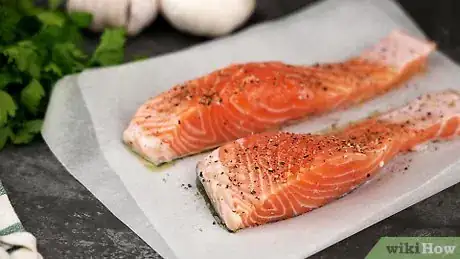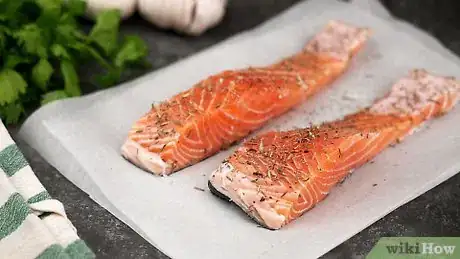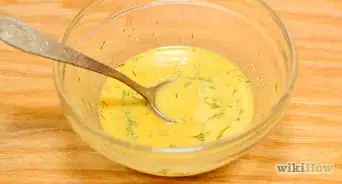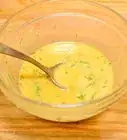This article was co-authored by wikiHow Staff. Our trained team of editors and researchers validate articles for accuracy and comprehensiveness. wikiHow's Content Management Team carefully monitors the work from our editorial staff to ensure that each article is backed by trusted research and meets our high quality standards.
There are 9 references cited in this article, which can be found at the bottom of the page.
The wikiHow Video Team also followed the article's instructions and verified that they work.
This article has been viewed 832,904 times.
Learn more...
Salmon is a versatile fish because its strong flavor stands up to a variety of spices. This flavorful fish is delicious seasoned with only salt and pepper, but the possibilities for how to season salmon are only limited to your imagination. You can simply sprinkle seasonings on before you cook the fish or use a spice rub. You can also try a glaze, marinade, or sauce to flavor the fish.
Steps
Sprinkling Seasoning on the Fish
-
1Create a very simple baked fish with olive oil, salt, and pepper. Pour a dollop of olive oil on top of the fillets, and use your fingers to rub it in. Sprinkle salt and pepper on top before popping the fish in the oven.[1] [2]
- Salmon has a wonderful flavor all on its own, so sometimes, simple seasonings are all you need.
- If you want, you can squeeze a bit of lemon on the salmon before serving.
-
2Try rosemary or thyme with roasted or broiled salmon. When salmon is cooked in one of these methods, the flavors of the fish get stronger, so you want strong herbs to go with it. Both rosemary and thyme can stand up to the stronger flavors of roasted salmon.
- Sprinkle on a bit of dried herbs with olive oil, or tuck a few pieces of fresh rosemary or thyme under the fish while it roasts.
Advertisement -
3
-
4Sprinkle on your favorite seasoning blend. Salmon is robust, and it can stand up to a variety of spices. Try sprinkling on taco seasoning, for instance, or Italian seasoning. It also does well with jerk seasoning, curry powder, Cajun seasoning, a Moroccan blend, or Chinese 5 spice. Just sprinkle the seasoning on the fish, and cook it how you'd like, by pan frying it, roasting it, or grilling it.
- If the blend doesn't have salt, consider adding a sprinkle to heighten the flavors.
- To brighten the fish, squeeze on some citrus juice at the end.
Using Seasoning Rubs
-
1Create a basic rub with salt, pepper, garlic, paprika, and olive oil. In a small bowl, pour in 1 teaspoon (4.9 mL) of smoked paprika, 1 teaspoon (4.9 mL) garlic powder, 1 teaspoon (4.9 mL) Kosher salt, and a couple of grinds of fresh black pepper. Pour in 1 tablespoon (15 mL) of olive oil and the juice and zest of 1 lemon. Stir the mixture well.[5]
- Rub the mixture on a salmon fillet that's about 2.5 pounds (1.1 kg). Let it rest for 10-15 minutes.
- Roast the fish in an oven that's 400 °F (204 °C) for 25 minutes.
-
2Try a sweet and spicy rub with brown sugar and spices. Add 2 spoonfuls of brown sugar to a small bowl. Pour in 1 tablespoon (15 mL) of chili powder and 1 teaspoon (4.9 mL) of cumin. Add in a couple of dashes of salt and pepper, and stir the mixture.[6]
- Start with 6 salmon fillets. Brush on olive oil, then brush the rub on the fillets.
- Grill the salmon for 5-6 minutes on each side.
-
3Make an earthy rub with cumin, coriander, and fennel. Pour 1 teaspoon (4.9 mL) of coriander seeds, 1 teaspoon (4.9 mL) of cumin seeds, and 2 teaspoons (9.9 mL) of fennel seeds into a spice grinder. Add in 1 teaspoon (4.9 mL) each of smoked paprika, garlic powder, and salt, as well as a few grinds of black pepper. Grind the mixture until it's a fine powder. Spread oil on the fish, and rub the mixture in. Let it sit for a few minutes before cooking.[7]
- For extra flavor, cook the seeds in a pan for 3-5 minutes until lightly brown before you grind them. You don't need oil for this process, but keep an eye on them, as they brown quickly.
- If you don't have a spice grinder, you can use pre-ground spices.
Adding Flavor with Glazes, Sauces, and Marinades
-
1Mix citrus with fresh herbs and olive oil for a quick flavor burst. Chop any fresh herbs you have on hand, from dill to parsley. Zest a lemon into a small bowl and squeeze the juice in. Add a dollop of olive oil, along with the fresh herbs.[8]
- You could also try fresh basil, rosemary, parsley, cilantro, or even mint.
- Spread the herb mixture on before baking or even pan frying.
- You can also use store-bought pesto instead.
-
2Create an Asian-style marinade for grilled salmon. When grilled, salmon's flavors intensify, so you need strong flavors to go with it. Try a marinade that incorporates flavors like fresh ginger and garlic to marinade your fish.
- Mix minced fresh garlic and ginger with a couple of dashes of soy sauce, a few drops of sesame oil, a dash or 2 of rice wine vinegar, and a spoonful of brown sugar to create your marinade. Let the fish marinate for at least 2 hours.
- You can sub honey for the brown sugar if you prefer.
- Cook the salmon in the marinade in a pan or drain it off if you want to grill it.
-
3Pour garlic, lemon juice, and butter into foil packets for an easy sauce. Add the juice of 1 lemon, 3 tablespoons (44 mL) of melted butter, 2 cloves of minced garlic, and 1⁄2 teaspoon (2.5 mL) of salt for 1.25 pounds (0.57 kg) of salmon. Close the packets, and cook the fish for about 15 minutes at 375 °F (191 °C). Open the packets to broil the fish for an additional 2-3 minutes at the end.[9]
- You can also add a dash of black pepper, oregano, and/or crushed red pepper, depending on your preferences.
- When plating, spoon out a bit of the sauce on top of the fish. Sprinkle with a bit of fresh, chopped parsley at the end.
-
4Use flavored butter at the end for a simple, flavorful "sauce." Let butter soften on the counter. Mix in your favorite fresh herbs or seasoning mix. For instance, add in a couple of dashes of Cajun seasoning or even Italian seasoning, along with some salt and pepper. After cooking the salmon, place a pat of the butter on top of the salmon to melt and flavor it.[10]
- You could also use black pepper or citrus zest.
- Try mixing in a bit of bourbon or whisky, along with a dash of honey or brown sugar.
-
5Make a quick, cool yogurt sauce with spices. You can use crème fraîche, yogurt, or even sour cream mixed with a bit of milk. Stir in any spices you like, such as dill, lemon zest, salt, and black pepper or curry powder.[11]
- You could also try scallions, sriracha, a little hot sauce, or fresh parsley and lemon zest.
Community Q&A
-
QuestionCan you eat salmon skin after it has been cooked?
 Community AnswerYes. It crisps up nicely and has a delicate taste compared to the meat of the salmon.
Community AnswerYes. It crisps up nicely and has a delicate taste compared to the meat of the salmon.
Warnings
- Wash your hands after touching raw salmon.⧼thumbs_response⧽
Things You'll Need
- Spices
- Zester, optional
- Small bowls
- Spice grinder, optional
- Pans
References
- ↑ https://www.traeger.com/learn/how-to-season-salmon
- ↑ https://www.thekitchn.com/how-to-cook-salmon-in-the-oven-cooking-lessons-from-the-kitchn-204559
- ↑ https://www.traeger.com/learn/how-to-season-salmon
- ↑ http://www.cookinglight.com/food/in-season/what-to-eat-right-now-pacific-salmon#our-favorite-salmon-flavor-combinations
- ↑ https://www.epicurious.com/recipes/food/views/lemon-paprika-roasted-salmon-51189020
- ↑ https://www.foodnetwork.com/recipes/ellie-krieger/salmon-with-sweet-spicy-rub-recipe-1953221
- ↑ https://www.garlicandzest.com/spiced-pan-sesared-salmon/
- ↑ https://www.thekitchn.com/5-easy-ways-to-dress-up-a-salmon-fillet-tips-from-the-kitchn-208745
- ↑ https://www.primaverakitchen.com/garlic-butter-salmon-in-foil-recipe/
About This Article
If you want to season salmon with a dry rub, combine your herbs and spices in a small bowl, then sprinkle the dry rub onto both sides of your salmon filet. For more intense flavor, let the salmon rest for about an hour before you cook it. If you would rather season your salmon with a marinade, make a mixture of wet ingredients like soy sauce and mustard, place the salmon filet in a resealable plastic bag and pour the marinade into the bag. Place the bag in the refrigerator and leave it there for about 8 hours, then cook the salmon. For more tips, including great glazes or marinades to use, read on!



























































